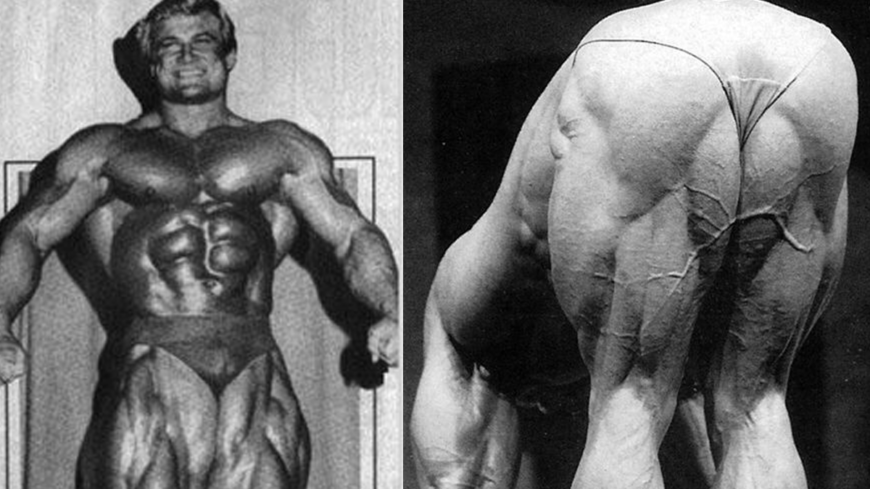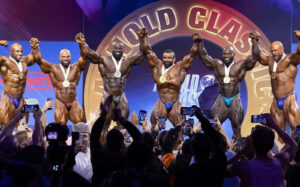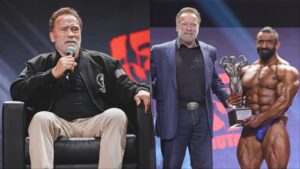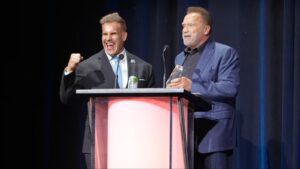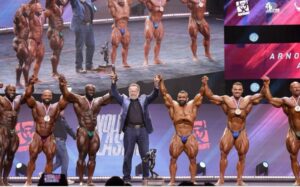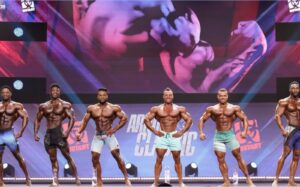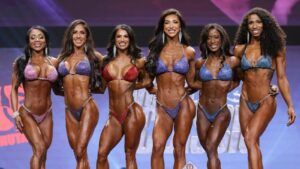If you’re a bodybuilding competitor, be aware that the glorious moon pose is a no-go on stage. This pose, which involves a bent-over hip hinge posture, is considered taboo by organizations such as the National Physique Committee and IFBB Professional League. It’s not just about avoiding offense – the pose is actually banned in modern physique competitions.
The moon pose is a bodybuilding pose that involves the athlete bending over and arching their back, with their buttocks facing the audience. It is named for its similarity to the appearance of the moon when it is in the crescent phase. The pose became popularized by bodybuilder Tom Platz, who was known for his impressive legs and crafty posing.
While the exact origins of the pose are unclear, Platz is credited with popularizing it in the bodybuilding world. Despite never winning the Mr. Olympia competition, Platz is considered one of the most famous and influential physique stars of all time, due in part to his skills in posing and posture.
However, the moon pose has been banned by many major bodybuilding organizations, including the National Physique Committee and the IFBB Professional League, perhaps for ethical reasons.
The Moon Pose: What Is It?
Tom Platz, nicknamed “The Quadfather,” became famous for his impressive leg development and used the moon pose to showcase his well-defined posterior muscles. To execute the pose, he faced his buttocks towards the audience and bent over from a standing position, highlighting the muscle lines in his glutes, hamstrings, and calves. Eight-time Mr. Olympia winner Ronnie Coleman also incorporated the pose into his competition routine, though it was not a signature part of his performance. Coleman was known for his exceptionally muscular backside, which made him well-suited for the moon pose. However, the moon pose is specifically used to show off muscle development and definition in the lower body.
Moon Pose Bodybuilding is a great way to gain muscle tone and strength
Here are some benefits of moon pose bodybuilding:
More flexibility
As a result of regularly practicing moon pose bodybuilding, you will be able to increase your flexibility and avoid injuries from forming at a later stage, which will benefit your overall health on a whole.
The increase in strength
Using moon pose bodybuilding presents you with the opportunity to strengthen your muscles, which enables you to lift heavier weights with a lower risk of injuring yourself.
Enhanced stability
Regular practice of moon poses can help you achieve good balance and coordination, which is also beneficial to your daily activities, as it can help you to maintain a good level of concentration and focus.
A lower risk of injury
By practicing the moon pose, you can develop strength and stability, which will reduce your risk of suffering from strains and injuries.
The Moon Pose Bodybuilding Technique: How to Learn It?
Moon pose bodybuilding can be taught by fitness instructors and trainers who are qualified to do so. If you are new to bodybuilding, the instructors can work with you to guide you through your routine, teach you proper form and technique, and make sure you are progressing safely. Furthermore, if you would like to gain a better understanding of the poses and movements of moon poses, you can research online and read books about the poses.
An Overview of the Dim Side of the Moon (Pose)
Despite showcasing a significant part of the body, the moon pose is banned in bodybuilding competitions. Some within the bodybuilding community view it as vulgar or inappropriate, and organizations may be trying to avoid any unwanted attention that muscular athletes may attract by exposing themselves so fully. There is little formal explanation for the prohibition of the moon pose on stage, but some competition regulations do classify it as a “lewd act.”
While the moon pose may be seen as an extravagant or showy way to highlight the muscles in the buttocks, hamstrings, and calves, there are other poses in bodybuilding that can effectively showcase these muscles. For example, the back double biceps pose allows judges to assess the physique from head to toe. Additionally, the moon pose may be considered redundant as it is not the only way to show off your legs.
In terms of mandatory poses, these are specific poses that bodybuilders must perform during competition. The exact poses required may vary depending on the organization or competition, but some common mandatory poses include the front double biceps, front lat spread, side chest, back double biceps, and side tricep. These poses are used to assess the overall symmetry, muscle size, and definition of the physique.
The Must-Have Bodybuilding Poses: What Are They?
It is important to note that bodybuilders are not required to perform the moon pose on stage during competitions. In fact, many bodybuilding organizations allow for freestyle posing routines, in which athletes can showcase their physiques in a way that reflects their individual personality or artistic vision. This gives bodybuilders the opportunity to express themselves and showcase their unique skills and abilities during their routines.
The Men’s Open bodybuilding and 212 divisions of the IFBB Pro League do have mandatory poses that bodybuilders must perform during competition. These poses are designed to showcase every muscle on the body and include: front double biceps, front lat spread, side chest, back double biceps, side tricep, most muscular, ab/thigh, and back lat spread. It is important for bodybuilders in these divisions to practice and perfect these poses in order to showcase their physique to the best of their ability on stage.
Side Triceps Pose:
The side triceps pose is used to showcase the muscles in the arms, chest, and shoulders. Athletes stand at right angles to the judges, wrap their arms behind their back and straighten their elbows to flex their triceps brachii. This pose is often used in bodybuilding competitions to highlight the definition and size of the triceps muscles.
Side Chest Pose:
The side chest pose is a bodybuilding pose that is used to showcase the size, shape, and definition of the pectorals (chest) muscles as well as the arms. To perform the pose, the bodybuilder stands fully perpendicular to the judges and bends their arm closest to the judges while pressing their far arm into their torso to flex the pectoral muscles. This pose is often used in competitions to highlight the muscles of the chest and arms.
Rear Lat Spread Pose:
The rear lat spread pose is used to assess the width and silhouette of the back muscles. To perform this pose, the athlete stands facing away from the judges and spreads their latissimus dorsi muscles as wide as possible, creating a “V” shape from the shoulders to the hips. This pose is often used in bodybuilding competitions to highlight the size and definition of the back muscles.
During the rear lat spread pose, judges often consider the shape and proportion of the lower body muscles, including those highlighted in the moon pose. This pose is used to assess the size and definition of the back muscles, and it allows judges to also evaluate the shape and proportion of the lower body muscles.
Back Double Biceps Pose:
The back double biceps pose is similar to the lat spread in that it is used to showcase the size of the arms, shoulders, and upper back muscles. To perform this pose, the bodybuilder flexes their bicep muscles and “spikes” one of their legs by pressing their toes firmly into the floor to tense their calves and glutes.
Front Double Biceps Pose:
Frontal poses like the double biceps allow bodybuilders to showcase their entire physique to the judges. To perform this pose, the athlete raises their arms and flexes their biceps muscles, flattens their stomach, and contracts their quadriceps muscles simultaneously.
Front Lat Spread Pose:
The front lat spread pose is used to showcase the width and thickness of the back muscles when viewed from the front. To perform this pose, the athlete assumes a similar posture to the rear lat spread, but they also flex their abdominal and thigh muscles.
Abdominal And Thighs Pose:
The Abdominal & Thigh pose is a bodybuilding pose that is used to showcase the muscularity and definition of the abdominal muscles and legs. During this pose, bodybuilders raise their arms behind their heads, highlighting every crevice and cut on their abs. They then flex their quadriceps and calves muscles to showcase the muscle size and definition in the lower body.
Most Muscular Pose:
The most muscular pose is a chance for bodybuilders to show off the size of their muscles to the judges. It is also a flexible pose that allows the athlete to flex their entire body in various ways. This pose is used to highlight the overall muscularity of the physique.
Here are some more bodybuilding poses:
Vacuum Pose
Classic physique competitors must perform the vacuum pose, which involves expanding their chest, exhaling their lungs completely, and squeezing their ab muscles. Practice is the key to getting it right. The goal is to create a hollow appearance on your abdomen beneath your ribs. Performing this move in the proper manner enhances the V-taper and exhibits your mastery of muscle control. A majority of male bodybuilders are unable to perform this pose due to their size. A small waist is an essential characteristic of the Classic Physique Division, which differentiates itself from the famous Men’s Open Division by emphasizing this pose.
Christmas Tree
It follows the same principle as the Rear Lat spread, where you are trying to flex your lats with a focus on the lower back region. Honestly, it has a lot more to do with activating the hips than activating the chest. Performing this pose correctly will produce an almost Christmas tree-like appearance to the muscles in your lower back.
Quarter Turn
There is an association that people have when they think of bodybuilders with the quarter-turn. The quarter turn is always the focal point of any advertisement or poster that you see. Despite being the simplest, it is also the easiest to get wrong. By turning slightly forward, you are basically showcasing your side profile. Your abs, chest, and obliques will be highlighted in this pose because of how tight they are.
Closing Thoughts
The moon pose has been a topic of debate within the bodybuilding community, with some seeing it as an important part of the sport’s history and others viewing it as unnecessarily bold. Many major organizations have banned the pose due to its controversial nature despite its popularity among bodybuilders.
Nonetheless, there have been many athletes who have achieved success in their sports careers as a result of practicing this pose, such as Tom Platz. The moon pose was a unique and effective way to showcase the muscles in the legs, but it is no longer permitted in modern bodybuilding competitions.

